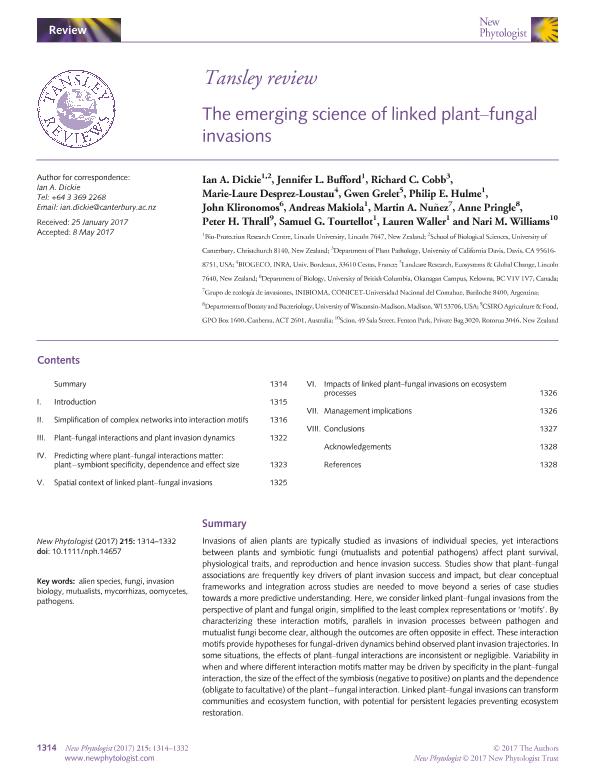Mostrar el registro sencillo del ítem
dc.contributor.author
Dickie, Ian A.
dc.contributor.author
Bufford, Jennifer L.
dc.contributor.author
Cobb, Richard C.
dc.contributor.author
Desprez Loustau, Marie-Laure
dc.contributor.author
Grelet, Gwen
dc.contributor.author
Hulme, Philip E.
dc.contributor.author
Klironomos, John
dc.contributor.author
Makiola, Andreas
dc.contributor.author
Nuñez, Martin Andres

dc.contributor.author
Pringle, Anne
dc.contributor.author
Thrall, Peter H.
dc.contributor.author
Tourtellot, Samuel G.
dc.contributor.author
Waller, Lauren
dc.contributor.author
Williams, Nari M.
dc.date.available
2018-11-27T13:44:39Z
dc.date.issued
2017-09
dc.identifier.citation
Dickie, Ian A.; Bufford, Jennifer L.; Cobb, Richard C.; Desprez Loustau, Marie-Laure; Grelet, Gwen; et al.; The emerging science of linked plant–fungal invasions; Wiley Blackwell Publishing, Inc; New Phytologist; 215; 4; 9-2017; 1314-1332
dc.identifier.issn
0028-646X
dc.identifier.uri
http://hdl.handle.net/11336/65272
dc.description.abstract
(Table presented.). Summary: Invasions of alien plants are typically studied as invasions of individual species, yet interactions between plants and symbiotic fungi (mutualists and potential pathogens) affect plant survival, physiological traits, and reproduction and hence invasion success. Studies show that plant–fungal associations are frequently key drivers of plant invasion success and impact, but clear conceptual frameworks and integration across studies are needed to move beyond a series of case studies towards a more predictive understanding. Here, we consider linked plant–fungal invasions from the perspective of plant and fungal origin, simplified to the least complex representations or ‘motifs’. By characterizing these interaction motifs, parallels in invasion processes between pathogen and mutualist fungi become clear, although the outcomes are often opposite in effect. These interaction motifs provide hypotheses for fungal-driven dynamics behind observed plant invasion trajectories. In some situations, the effects of plant–fungal interactions are inconsistent or negligible. Variability in when and where different interaction motifs matter may be driven by specificity in the plant–fungal interaction, the size of the effect of the symbiosis (negative to positive) on plants and the dependence (obligate to facultative) of the plant−fungal interaction. Linked plant–fungal invasions can transform communities and ecosystem function, with potential for persistent legacies preventing ecosystem restoration.
dc.format
application/pdf
dc.language.iso
eng
dc.publisher
Wiley Blackwell Publishing, Inc

dc.rights
info:eu-repo/semantics/openAccess
dc.rights.uri
https://creativecommons.org/licenses/by-nc-sa/2.5/ar/
dc.subject
Alien Species
dc.subject
Fungi
dc.subject
Invasion Biology
dc.subject
Mutualists
dc.subject
Mycorrhizas
dc.subject
Oomycetes
dc.subject
Pathogens
dc.subject.classification
Otras Ciencias Biológicas

dc.subject.classification
Ciencias Biológicas

dc.subject.classification
CIENCIAS NATURALES Y EXACTAS

dc.title
The emerging science of linked plant–fungal invasions
dc.type
info:eu-repo/semantics/article
dc.type
info:ar-repo/semantics/artículo
dc.type
info:eu-repo/semantics/publishedVersion
dc.date.updated
2018-10-23T16:18:22Z
dc.journal.volume
215
dc.journal.number
4
dc.journal.pagination
1314-1332
dc.journal.pais
Reino Unido

dc.journal.ciudad
Londres
dc.description.fil
Fil: Dickie, Ian A.. Lincoln University; Nueva Zelanda. University Of Canterbury; Nueva Zelanda
dc.description.fil
Fil: Bufford, Jennifer L.. Lincoln University; Nueva Zelanda
dc.description.fil
Fil: Cobb, Richard C.. University of California at Davis; Estados Unidos
dc.description.fil
Fil: Desprez Loustau, Marie-Laure. Universite de Bordeaux; Francia
dc.description.fil
Fil: Grelet, Gwen. Ecosystems & Global Chang; Nueva Zelanda
dc.description.fil
Fil: Hulme, Philip E.. Lincoln University; Nueva Zelanda
dc.description.fil
Fil: Klironomos, John. University of British Columbia; Canadá
dc.description.fil
Fil: Makiola, Andreas. Lincoln University; Nueva Zelanda
dc.description.fil
Fil: Nuñez, Martin Andres. Consejo Nacional de Investigaciones Científicas y Técnicas. Centro Científico Tecnológico Conicet - Patagonia Norte. Instituto de Investigaciones en Biodiversidad y Medioambiente. Universidad Nacional del Comahue. Centro Regional Universidad Bariloche. Instituto de Investigaciones en Biodiversidad y Medioambiente; Argentina
dc.description.fil
Fil: Pringle, Anne. University Of Wisconsin Madison; Estados Unidos
dc.description.fil
Fil: Thrall, Peter H.. Csiro Agriculture Flagship; Australia
dc.description.fil
Fil: Tourtellot, Samuel G.. Lincoln University; Nueva Zelanda
dc.description.fil
Fil: Waller, Lauren. Lincoln University; Nueva Zelanda
dc.description.fil
Fil: Williams, Nari M.. Scion; Nueva Zelanda
dc.journal.title
New Phytologist

dc.relation.alternativeid
info:eu-repo/semantics/altIdentifier/doi/https://dx.doi.org/10.1111/nph.14657
dc.relation.alternativeid
info:eu-repo/semantics/altIdentifier/url/https://nph.onlinelibrary.wiley.com/doi/full/10.1111/nph.14657
Archivos asociados
